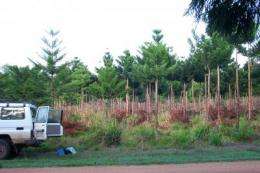Reforestation projects capture more carbon than industrial plantations, reveals new research

Australian scientists researching environmental restoration projects have found that the reforestation of damaged rainforests is more efficient at capturing carbon than controversial softwood monoculture plantations. The research, published in Ecological Management & Restoration, challenges traditional views on the efficiency of industrial monoculture plantations.
"Carbon markets have become a potential source of funding for restoration projects as countries and corporations seek the cheapest way to reduce carbon emissions", said Dr John Kanowski from the Australian Wildlife Conservancy. "However, there is a concern that this funding will encourage single species monoculture plantations instead of diverse reforestation projects, due to the widely held belief that monocultures capture more carbon."
Softwood monoculture plantations are grown for industrial purposes and are used as a cheap and abundant source of resources such as timber and rubber. However the plantations are highly controversial, with some ecologists describing the lack of diversity as a 'green desert'.
The team sought to test the belief that monoculture plantations would capture more carbon by studying three types of projects in north-eastern Australia: monoculture plantations of native conifers, mixed species plantations and rainforest restoration projects comprised of a diverse range of rainforest trees.
"We found that restoration planting stored significantly more carbon in above-ground biomass than the monoculture plantations of native conifers and tended to store more than mixed species timber plantations," said Kanowski. "Compared to the monoculture plantations reforestation projects were more densely stocked, there were more large trees and the trees which were used had a higher wood density then the conifers at the plantation."
These findings challenge the existing view of monoculture plantations. For example the Australian Government's National Carbon Accounting Tool Box predicts that monoculture plantations would sequester 40% more carbon then restoration plantings in northern Australia, yet this study demonstrated that carbon stocks were higher in restoration plantings then in either mixed-species plantations or monoculture plantations.
The research also suggests that restoration plantings store more carbon over time. However, as restoration projects are more expensive then monoculture plantations it is unlikely that carbon markets will favour restoration.
"In order to be an attractive prospect for the markets new reforestation techniques and designs are going to be required," concluded Kanowski. "New designs will have to ensure that restoration can provide a habitat for rainforest life and store carbon at a cost comparable to industrial monoculture."
More information: Kanowski. J, Catterall. C, ‘Carbon stocks in above-ground biomass of monoculture and mixed species plantations and environmental restoration plantings in north-east Australia’, Ecological Management & Restoration, Wiley-Blackwell, July 2010: DOI: 10.1111/j.1442-8903.2010.005289
Provided by Wiley















